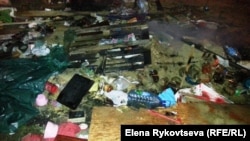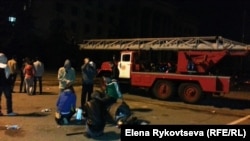At 4:10 p.m., I got on the minibus (marshrutka), which was heading toward the center of town. At 4:30 p.m., I had a meeting planned with the general producer of the Odesa Film Studio, Viktor Nozdryukhin-Zabolotny, at Cafe Gorsada, near Deribasivska. I was planning to ask him how the violence is affecting Ukrainian and Russian filmmakers.
At 4:30, I got off the bus at the intersection of Bunin Street and Aleksandrovskiy Prospekt. And I saw how a column of demonstrators was moving along Bunin Street. At the head of the column, for some reason, was a fire truck. The column stopped on Bunin Street. I walked up and began taking pictures of the demonstrators. Many of them were wearing helmets and in camouflage. I began to ask them what was happening.
They said that they were mostly fans of Chernomorets and Metallist. That they had come to march in support of a unified Ukraine. It was not the first such march, but this time they found out through social networking that anti-Maidan supporters were calling for everyone to gather and crush the unification march.
I asked about where and when such an attack might take place. They answered that the anti-Maidan protesters were walking on a parallel street and were now turning toward where we were.
All the time they received messages on their mobile phones about the movements of the anti-Maidan group.
At one moment a signal was given: "They're here."
The column instantly regrouped and in front appeared a solid line of people holding shields.
Then there was quiet for 30 seconds.
But then, from the direction of Aleksandrovskiy Street, people suddenly ran at them. All these people, oddly enough, were wearing orange helmets. The football fans did not hesitate when the orange helmets broke through the first row (with shields) and jumped toward them. A scuffle broke out. I saw that on the street a police car was driving toward them. Until this time, the police had been nowhere in sight. That is to say, while everyone knew all about one another, the police did not know anything about anyone.
At the same time, in the direction of Deribasivska, gunshots could be heard and smoke appeared. I walked toward there.
On Deribasivska, I realized that yet another fight was going on. It was happening in the direction of the cafe where Viktor Nozdryukhin-Zabolotny was waiting for me. I could not walk to this cafe straight ahead on Deribasivska. I had to walk around across the city garden. I walked to the cafe under the terrifying roar of gunfire and flash grenades. The waitresses pushed the tables and chairs off the street, fearing the worst.
Viktor and I finally met, greeted each other, and decided to move our conversation to a safer place.
What happened next is now widely known.
In the center of the city, fighting broke out. People died. As soon as the information arrived about the first victims among the supporters of a united Ukraine, a call appeared on social networks to go toward Kulikovo field and destroy the anti-Maidan camp.
I wrote about this camp in my first report from Odesa. It was located on the square next to the building of the regional trade union council. In the early evening, as I was going home, I was near it. It was always nearly empty there. There were only a few people in tents. I know that many Odesa residents were astounded: Why didn't the government break up the camp? Moreover, there was no special support for it in the city. But apparently this question was along the same lines as, "What are the police looking out for?" Nothing.
When the "Maidanovtsy" returned to Kulikovo field with the firm intention to destroy the camp, its inhabitants rushed into the trade-union building and barricaded themselves there. The "Maidanovtsy" set fire to the tents. But the building of the trade-union building also caught fire. This is the subject of a separate investigation because Molotov cocktails were being thrown from both inside and outside the building.
I went to the Kulikovo field late in the evening, when the fire had already been extinguished. Instead of tents were ashes.
Near there were the fire trucks on duty and the ambulances. I talked with a doctor. He said that there were dozens wounded. Many had gunshot wounds. There were stab wounds; there were broken bones. I asked how many had died. He said, "We're busy with the living."
By the time I walked out of the building, five corpses were laid out. And then I saw two girls, one of whom was crying on the shoulder of the other. It turned out that she was mourning her boyfriend, who had died that day from gunfire on Deribasivska. His name was Igor Ivanov. He was an assistant judge in the Primorskiy District of the city of Odesa.
I am shocked at how this story played out. How they said, "On May 1 or 2 in Odesa, many provocations are expected." And so they happened.
Some murders are announced. Everyone knows, everyone waits, but nobody can (or wants to) prevent them.
By the way, residents of the city have told me that Odesa real-estate brokers, in all seriousness, ask, "To whom are you renting your apartment? Spies?" I am convinced that all rented apartments, that all of the sanatoriums, of Odesa are inundated with men from Russia who live quietly in rooms alone or with another person. Biding their time.
Who knows if their hour just struck or if this is only the beginning.
More photos here

















